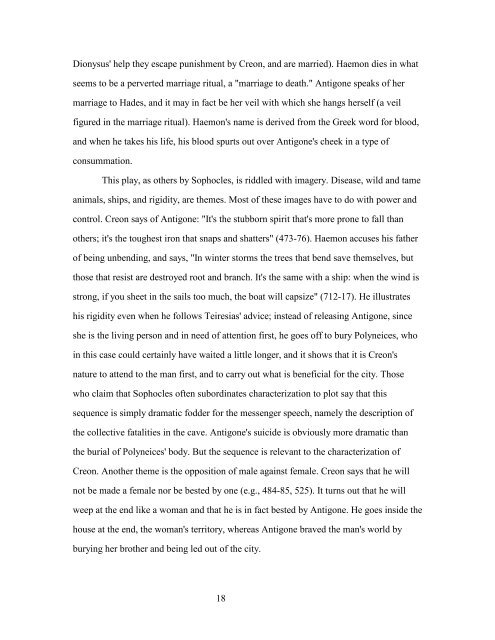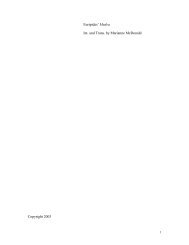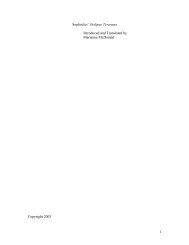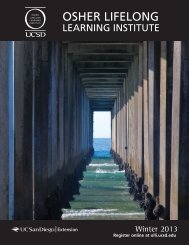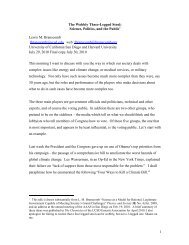1 Sophocles' Antigone Introduction, translation, and notes by ...
1 Sophocles' Antigone Introduction, translation, and notes by ...
1 Sophocles' Antigone Introduction, translation, and notes by ...
Create successful ePaper yourself
Turn your PDF publications into a flip-book with our unique Google optimized e-Paper software.
Dionysus' help they escape punishment <strong>by</strong> Creon, <strong>and</strong> are married). Haemon dies in what<br />
seems to be a perverted marriage ritual, a "marriage to death." <strong>Antigone</strong> speaks of her<br />
marriage to Hades, <strong>and</strong> it may in fact be her veil with which she hangs herself (a veil<br />
figured in the marriage ritual). Haemon's name is derived from the Greek word for blood,<br />
<strong>and</strong> when he takes his life, his blood spurts out over <strong>Antigone</strong>'s cheek in a type of<br />
consummation.<br />
This play, as others <strong>by</strong> Sophocles, is riddled with imagery. Disease, wild <strong>and</strong> tame<br />
animals, ships, <strong>and</strong> rigidity, are themes. Most of these images have to do with power <strong>and</strong><br />
control. Creon says of <strong>Antigone</strong>: "It's the stubborn spirit that's more prone to fall than<br />
others; it's the toughest iron that snaps <strong>and</strong> shatters" (473-76). Haemon accuses his father<br />
of being unbending, <strong>and</strong> says, "In winter storms the trees that bend save themselves, but<br />
those that resist are destroyed root <strong>and</strong> branch. It's the same with a ship: when the wind is<br />
strong, if you sheet in the sails too much, the boat will capsize" (712-17). He illustrates<br />
his rigidity even when he follows Teiresias' advice; instead of releasing <strong>Antigone</strong>, since<br />
she is the living person <strong>and</strong> in need of attention first, he goes off to bury Polyneices, who<br />
in this case could certainly have waited a little longer, <strong>and</strong> it shows that it is Creon's<br />
nature to attend to the man first, <strong>and</strong> to carry out what is beneficial for the city. Those<br />
who claim that Sophocles often subordinates characterization to plot say that this<br />
sequence is simply dramatic fodder for the messenger speech, namely the description of<br />
the collective fatalities in the cave. <strong>Antigone</strong>'s suicide is obviously more dramatic than<br />
the burial of Polyneices' body. But the sequence is relevant to the characterization of<br />
Creon. Another theme is the opposition of male against female. Creon says that he will<br />
not be made a female nor be bested <strong>by</strong> one (e.g., 484-85, 525). It turns out that he will<br />
weep at the end like a woman <strong>and</strong> that he is in fact bested <strong>by</strong> <strong>Antigone</strong>. He goes inside the<br />
house at the end, the woman's territory, whereas <strong>Antigone</strong> braved the man's world <strong>by</strong><br />
burying her brother <strong>and</strong> being led out of the city.<br />
18


